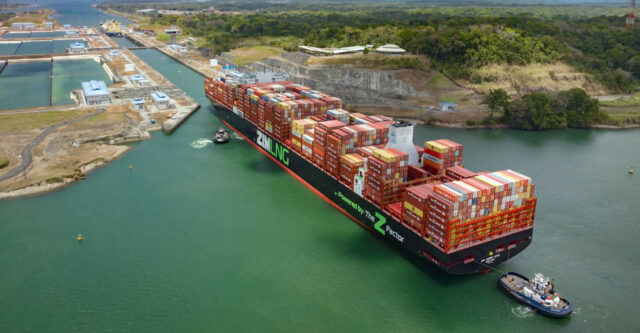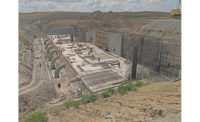Water Projects
Panama Canal Proposes New Reservoir to Secure Water Supply
March 15, 2024
Water Projects
Panama Canal Proposes New Reservoir to Secure Water Supply
March 15, 2024Daily transits through the Panama Canal have been slashed due to ongoing drought conditions. Officials have proposed building a new reservoir to meet growing waterway needs.
Photo courtesy Panama Canal Authority
Worries about water have plagued the Panama Canal from the very beginning.
In 1914, Engineering News – the precursor to ENR – posted an editorial scolding those who shared these “dire predictions” of disaster from insufficient water for the canal. The editors cited a year's statistics showing stable water levels on the newly-created Gatun Lake as evidence to the contrary.
“There is water enough at Panama to handle probably three times as much traffic as now passes via Suez,” the editorial proclaimed.
And, indeed there was. But demands on Panama’s water supply from the canal have continued to drain it ever ever since — and the need for new sources has continued as well.
Last year, drought and El Niño conditions conspired to deliver one of the driest years in the canal’s history, forcing the Panama Canal Authority (known by its Spanish-language acronym ACP) to dramatically reduce transits and launch a battery of water conservation measures.
In addition to the short-term measures, the ACP has taken the initial steps for creating a new reservoir in the sparsely-populated Coclé province to the west of the canal. If built, the Rio Indio reservoir is expected to bolster the waterways’ freshwater needs for the next fifty years.
According to officials, the project would cost approximately $900 million and could be completed in five years. The process can begin as soon as the government of Panama approves a pair of measures needed to move forward with the proposal.
“Once this happens, we will be ready to go,” said Panama Canal Administrator Ricaurte Vásquez Morales in January.

The Gatun Lake comprises 21 miles of the Panama Canal's 50-mile-long course.
Photo by Scott Blair/ENR
A Man, a Plan, a Reservoir
The U.S. Army Corps of Engineers has studied possibility of a reservoir on the Indio River as far back as the late 1990s, when the option of building a third set of locks began in earnest. While the growth of global cargo shipping was a major factor for the Neopanamax locks, canal officials also cited concerns about water resources in the wake of a 1997 El Niño event as the primary reason to launch the ambitious building effort.
ACP 2003 Report:
Feasibility Design for the Rio Indio Water Supply Project
In 2003, canal officials produced a feasibility report for the Rio Indio reservoir. This report called for a concrete-face rockfill dam with a crest at 83 ft. The reservoir would be connected to Gatun Lake via a 8,350-meter-long, 4.5-m-dia tunnel. Two saddle dams would be required to maintain the reservoir’s full supply level. The minimum release facility, sized to pass 2.5 cu m per second, would also include a 1.6-MW power plant.
The resulting reservoir would have a gross storage capacity of 1,577 million cu m and cover almost 46 sq kilometers. Estimates at the time projected the new reservoir would provide 1,200 million cu m of water per year to the canal watershed.
The 2003 report projected a five-year construction timeline for the project. Due to the remote location, the first 16 months would require mobilization, competing access roads, and establishing the construction camp. John Langman, vice president of water projects office at the Panama Canal, says the current projected construction timeline would be similar.
“The construction of a reservoir in the Indio River basin, as an additional water reserve for the population and Canal operations, would be ready within four to five years from the date of the order to proceed with its construction, and after reaching consensus with the communities that could be affected,” he adds.

The proposed Rio Indio reservoir is outside of the canal's current watershed.
Map by Scott Hilling/ENR, original inset map by Getty Images
Recent reviews by both the USACE and the ACP found that meeting the canal's growing water needs due to the increasing threat of similar drought conditions would not be possible using conservation measures in the watershed alone. A new reservoir would be the only practical solution.
Last September, ACP officials delivered a proposal to the Panamanian government, hoping to advance the process of finding solutions. The proposal called for an expansion of the ACP’s legal operating limits to include the area of the proposed reservoir and to eliminate its restriction on constructing new reservoirs.
Both of these items were restricted in a law passed in 2006 following a referendum that approved the construction of the canals’ third lane expansion.
“Today, in 2024, we face higher demands for human consumption and transiting vessels than those assumed in the 2006 canal master plan, and these demands are expected to continue growing. We are also experiencing increased weather variability, with more frequent relatively dry years,” Langman says.
For the Rio Indio reservoir to move forward, the Cabinet Council of the Government of Panama must approve the proposal before it can be sent to the National Assembly for consideration. To date, the government has taken no action on the matter.
While groups such as the Association Panama Canal Pilots have urged the government to move quickly, those representing farmers in the region of the proposed reservoir have pledged to oppose it. With Panama facing a presidential election on May 5, it’s unclear if any action regarding the canal proposal will be able to move forward until after that date.
One presidential candidate is former President Martín Torrijos. During his prior tenure (2004-2009), he oversaw the successful referendum for the canal’s third lane expansion. If reelected, he has promised to move forward with the reservoir project in order to preserve the country’s role as a logistics hub for the hemisphere.
“We are reaching a point where we have to make new decisions and talk to the world about the future of Panama and the role we want to play within global logistics,” he said in an interview with the business newspaper Capital Financiero.

The Neopanamax locks' water saving basins reuse 60% of the water needed for transits through the canal.
Photo by Scott Blair/ENR
The Shape of Water
The Gatun Lake is the heart of the Panama Canal. The lake covers approximately 164 sq miles and provides 21 miles of the canal’s 50-mile-long course. The famed locks at either end of the canal serve to raise and lower vessels from sea level to the height of the lake, about 85 ft total.
The lake itself was created in 1913 by damming the Chagres River near its mouth on the Caribbean Sea. Upon its completion, the Gatun Dam was the largest earthen dam in the world; when the Gatun Lake was fully impounded, it was the largest artificial lake in the world.
Initially, Gatun Lake was sufficient for the canal’s needs, but water demands grew quickly. Just three decades later, the Chagres River was dammed further upstream to create Lake Alajuela. Today, this lake contributes as much as 45% of the total water for the canal.
A severe El Niño event in 1997 prompted Canal officials to begin planning the construction of a third lane of locks in part due to the growing importance of water conservation. The original Panamax locks use about 50 million gallons of water with each transit. When the Neopanamax locks were completed in 2016, they featured water-saving basins that conserved 60% of that amount.
This loss of freshwater affects the entire country, as the canal’s reservoirs are Panama’s primary source of drinking water. Inflows of salty water that occur as vessels pass through the locks require additional freshwater to mitigate. If the salt levels of the Gatun lake rise too high, the water becomes non-potable and may result in multiple negative ecological impacts.
While increased canal traffic has put strains on the water supply, so has the country’s growing population. As of 2023, the total population topped 4.4 million and more than three-quarters of those residents were located in the Panama City metropolitan area.
“When facing water scarcity, as was the case in 2023, the Canal applies aggressive water saving measures, but the salinity intrusion limits our capability to be as aggressive as we otherwise may be,” Langman explains. “Salinity levels are tracked closely, and water-saving measures are eased if needed, and other operating measures are taken, such as reducing the number of transits, to remain within safe thresholds.”
In normal conditions, this system works with remarkable efficiency, but dramatic changes in weather and climate can play havoc with the process.
Source: Panama Canal Authority
Graphic by C.J. Schexnayder/ENR
The Driest Season
Additional ENR Panama Canal Coverage
Severe Drought Prompts Panama Canal Passage Limits - July 31, 2023
Panama Canal Rescopes $2B Water Supply Scheme to Cut Contractor Risk - March 2, 2022
Panama Canal Expansion Wraps Up - June 15, 2016
Panama Canal Construction Shapes the Future for Shipping - April 25, 2007
Canal Authority's Director of Engineering and Projects In an Expansive Mood - April 25, 2007
EDITORIALS: Water Supply of the Panama Canal - August 6, 1914
Panama’s rainy season runs from April to November. At the end of 2022, the possibility of a water crisis on the canal seemed remote as Gatun Lake’s water level reached almost 89 ft—well over the typical level to end the season. The next rainy season was unusually dry— and, immediately after, an El Niño cycle further interrupted the expected levels of precipitation.
Last October was the driest in the history of the Panama Canal watershed, with precipitation 41% lower than usual. During that month, the Gatun reservoir’s daily rainwater and river flow reached 7 million cu m, less than half of the typical amount. The result was a daily deficit of 3 million cu m of water.
In response, daily transits of the waterway were reduced by one-third to 24 in November and reduced again to 22 in December. The typical maximum of total daily transits is about 40 vessels. Additionally, vessels transiting the Neopanamax locks are restricted to maximum drafts of up to 44 ft (those transiting via the Panamax locks have had no draft restrictions). The usual maximum draft is approximately 50 ft.
The result has been a decrease in cargo transiting the waterway and an increase in wait times for vessels to make the passage.
A slight increase in rainfall around Christmas allowed the ACP to resume the 24 per day number in January. On March 11, canal officials began allowing an additional three transits per day through in the Panamax locks. The maximum draft limits have not been changed.
To conserve water, canal officials increased the use of other conservation measures such as the repeated use of Neopanamax locks’ water-saving basins and cross-filling the Panamax locks. Cross-filling, where the water from one of the Panamax lock chambers is used to fill an adjacent one, saves the equivalent consumption of six daily transits.
These efforts helped reduce the amount of water being lost to the open ocean, while also mitigating the amount of salt water being introduced into the freshwater watershed. Currently, the bulk of the freshwater taken from the canal watershed for consumption is via Alhajuela Lake, which is not exposed to any salinity intrusion.

In January, daily transits were increased to 27 per day but still remain far below the maximum of 40.
Photo courtesy Panama Canal Authority
The recent freshwater shortage comes as ACP officials have been looking for conservation alternatives. In September 2020, canal officials sought bids for a $2-billion effort to bolster the canal watershed. The proposed program was aimed at forestalling the canal’s needs as well as accommodating the country’s drinking water supply through 2070. Less than a year later, after receiving hundreds of responses from interested contractors concerned about the degree of risk the project would entail, ACP officials withdrew the tender.
Canal officials then turned to the Corps. In November 2022, the Corps was contracted to review all the available studies and data to help define the scope of work for a future bid package. At the time, the deadline to complete the work was set for this year with a completion date of 2028 for the proposed portfolio of projects.
“The waterway’s specialists—in conjunction with the Corps—have confirmed that technical solutions within the Panama Canal’s jurisdiction are not sufficient to meet the growing demand for water,” Langman says.
While the solution seem straightforward, the timeline remains unknown. The problem, notes former canal administrator Jorge Luis Quijano, is that delaying a decision to proceed could be disastrous.
“If we are able to get started this year, we should be ready to handle the next El Niño,” he says. “If we don't do anything now, waiting another year, we'll be caught with the worst situation.”









